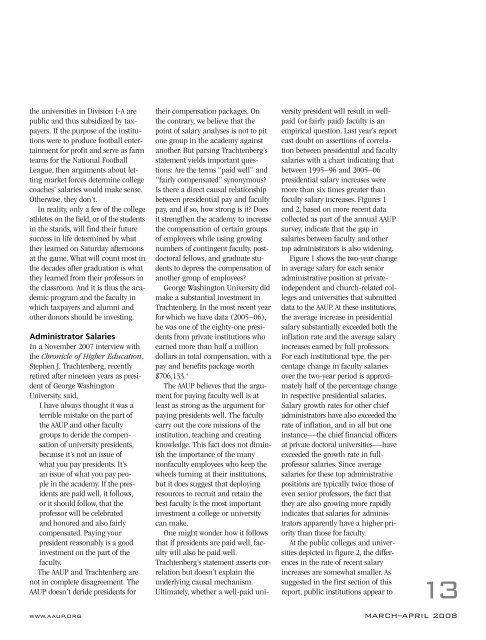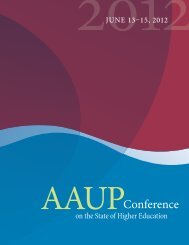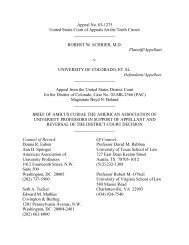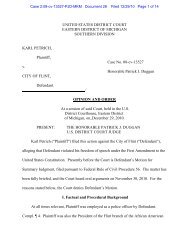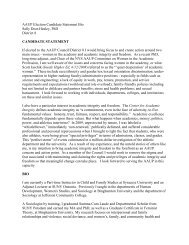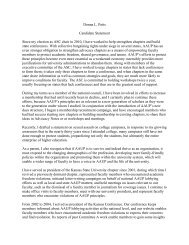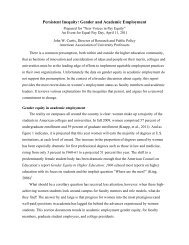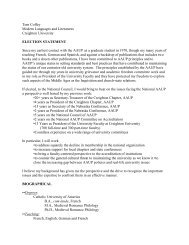report - American Association of University Professors
report - American Association of University Professors
report - American Association of University Professors
Create successful ePaper yourself
Turn your PDF publications into a flip-book with our unique Google optimized e-Paper software.
the universities in Division I-A are<br />
public and thus subsidized by taxpayers.<br />
If the purpose <strong>of</strong> the institutions<br />
were to produce football entertainment<br />
for pr<strong>of</strong>it and serve as farm<br />
teams for the National Football<br />
League, then arguments about letting<br />
market forces determine college<br />
coaches’ salaries would make sense.<br />
Otherwise, they don’t.<br />
In reality, only a few <strong>of</strong> the college<br />
athletes on the field, or <strong>of</strong> the students<br />
in the stands, will find their future<br />
success in life determined by what<br />
they learned on Saturday afternoons<br />
at the game. What will count most in<br />
the decades after graduation is what<br />
they learned from their pr<strong>of</strong>essors in<br />
the classroom. And it is thus the academic<br />
program and the faculty in<br />
which taxpayers and alumni and<br />
other donors should be investing.<br />
Administrator Salaries<br />
In a November 2007 interview with<br />
the Chronicle <strong>of</strong> Higher Education,<br />
Stephen J. Trachtenberg, recently<br />
retired after nineteen years as president<br />
<strong>of</strong> George Washington<br />
<strong>University</strong>, said,<br />
I have always thought it was a<br />
terrible mistake on the part <strong>of</strong><br />
the AAUP and other faculty<br />
groups to deride the compensation<br />
<strong>of</strong> university presidents,<br />
because it’s not an issue <strong>of</strong><br />
what you pay presidents. It’s<br />
an issue <strong>of</strong> what you pay people<br />
in the academy. If the presidents<br />
are paid well, it follows,<br />
or it should follow, that the<br />
pr<strong>of</strong>essor will be celebrated<br />
and honored and also fairly<br />
compensated. Paying your<br />
president reasonably is a good<br />
investment on the part <strong>of</strong> the<br />
faculty.<br />
The AAUP and Trachtenberg are<br />
not in complete disagreement. The<br />
AAUP doesn’t deride presidents for<br />
their compensation packages. On<br />
the contrary, we believe that the<br />
point <strong>of</strong> salary analyses is not to pit<br />
one group in the academy against<br />
another. But parsing Trachtenberg’s<br />
statement yields important questions:<br />
Are the terms “paid well” and<br />
“fairly compensated” synonymous?<br />
Is there a direct causal relationship<br />
between presidential pay and faculty<br />
pay, and if so, how strong is it? Does<br />
it strengthen the academy to increase<br />
the compensation <strong>of</strong> certain groups<br />
<strong>of</strong> employees while using growing<br />
numbers <strong>of</strong> contingent faculty, postdoctoral<br />
fellows, and graduate students<br />
to depress the compensation <strong>of</strong><br />
another group <strong>of</strong> employees?<br />
George Washington <strong>University</strong> did<br />
make a substantial investment in<br />
Trachtenberg. In the most recent year<br />
for which we have data (2005–06),<br />
he was one <strong>of</strong> the eighty-one presidents<br />
from private institutions who<br />
earned more than half a million<br />
dollars in total compensation, with a<br />
pay and benefits package worth<br />
$706,133. 4<br />
The AAUP believes that the argument<br />
for paying faculty well is at<br />
least as strong as the argument for<br />
paying presidents well. The faculty<br />
carry out the core missions <strong>of</strong> the<br />
institution, teaching and creating<br />
knowledge. This fact does not diminish<br />
the importance <strong>of</strong> the many<br />
nonfaculty employees who keep the<br />
wheels turning at their institutions,<br />
but it does suggest that deploying<br />
resources to recruit and retain the<br />
best faculty is the most important<br />
investment a college or university<br />
can make.<br />
One might wonder how it follows<br />
that if presidents are paid well, faculty<br />
will also be paid well.<br />
Trachtenberg’s statement asserts correlation<br />
but doesn’t explain the<br />
underlying causal mechanism.<br />
Ultimately, whether a well-paid university<br />
president will result in wellpaid<br />
(or fairly paid) faculty is an<br />
empirical question. Last year’s <strong>report</strong><br />
cast doubt on assertions <strong>of</strong> correlation<br />
between presidential and faculty<br />
salaries with a chart indicating that<br />
between 1995–96 and 2005–06<br />
presidential salary increases were<br />
more than six times greater than<br />
faculty salary increases. Figures 1<br />
and 2, based on more recent data<br />
collected as part <strong>of</strong> the annual AAUP<br />
survey, indicate that the gap in<br />
salaries between faculty and other<br />
top administrators is also widening.<br />
Figure 1 shows the two-year change<br />
in average salary for each senior<br />
administrative position at privateindependent<br />
and church-related colleges<br />
and universities that submitted<br />
data to the AAUP. At these institutions,<br />
the average increase in presidential<br />
salary substantially exceeded both the<br />
inflation rate and the average salary<br />
increases earned by full pr<strong>of</strong>essors.<br />
For each institutional type, the percentage<br />
change in faculty salaries<br />
over the two-year period is approximately<br />
half <strong>of</strong> the percentage change<br />
in respective presidential salaries.<br />
Salary growth rates for other chief<br />
administrators have also exceeded the<br />
rate <strong>of</strong> inflation, and in all but one<br />
instance—the chief financial <strong>of</strong>ficers<br />
at private doctoral universities—have<br />
exceeded the growth rate in fullpr<strong>of</strong>essor<br />
salaries. Since average<br />
salaries for these top administrative<br />
positions are typically twice those <strong>of</strong><br />
even senior pr<strong>of</strong>essors, the fact that<br />
they are also growing more rapidly<br />
indicates that salaries for administrators<br />
apparently have a higher priority<br />
than those for faculty.<br />
At the public colleges and universities<br />
depicted in figure 2, the differences<br />
in the rate <strong>of</strong> recent salary<br />
increases are somewhat smaller. As<br />
suggested in the first section <strong>of</strong> this<br />
<strong>report</strong>, public institutions appear to<br />
13<br />
WWW.AAUP.ORG MARCH–APRIL 2008


